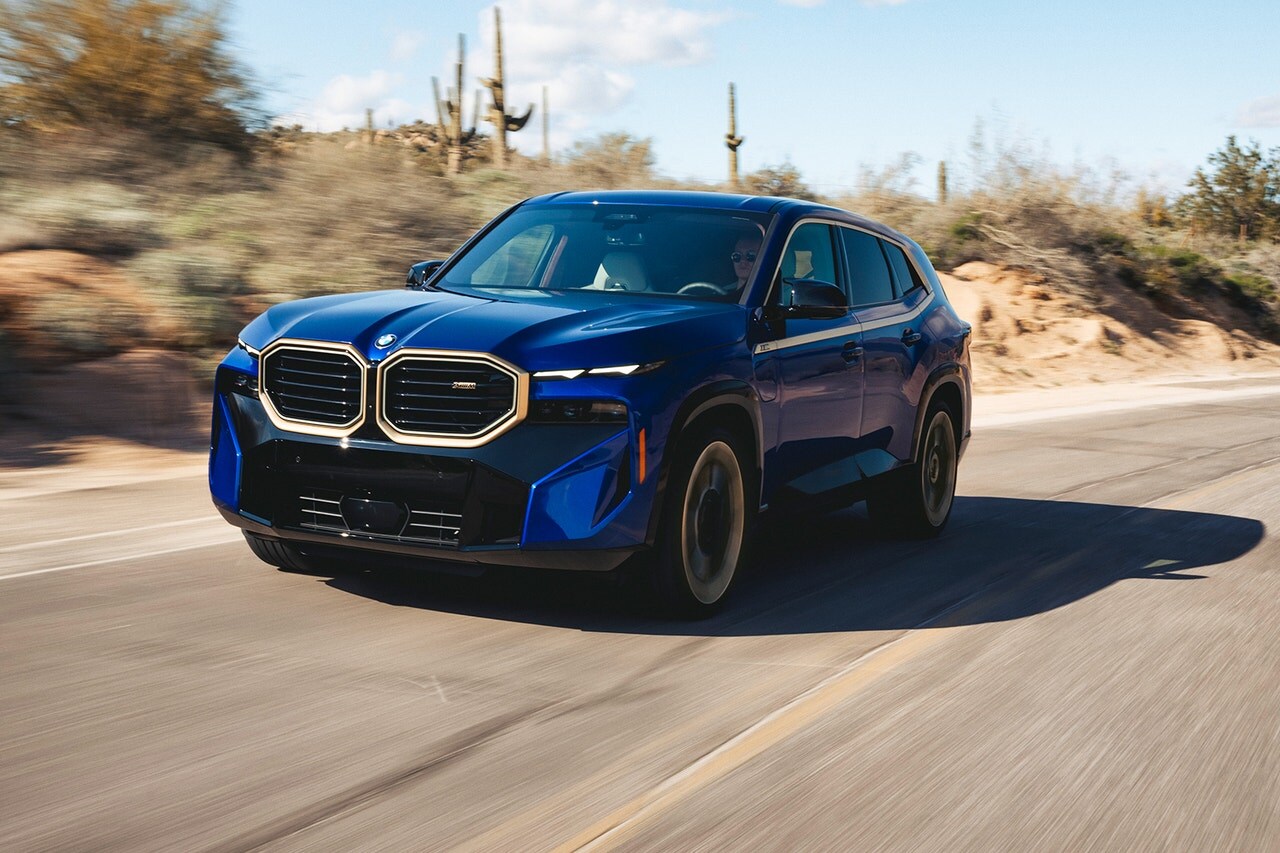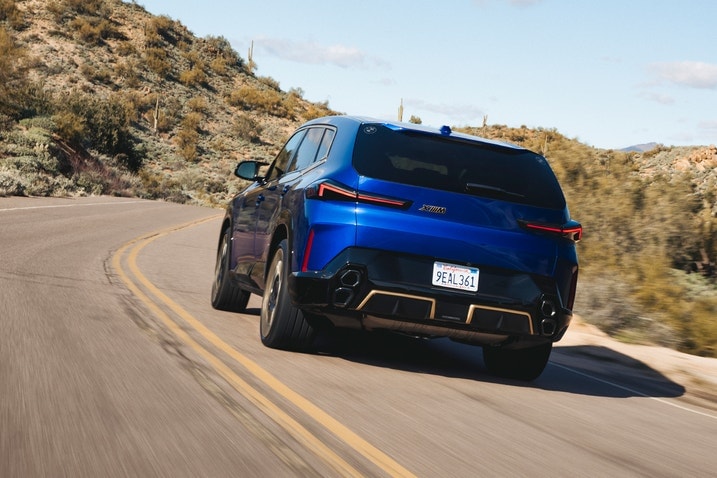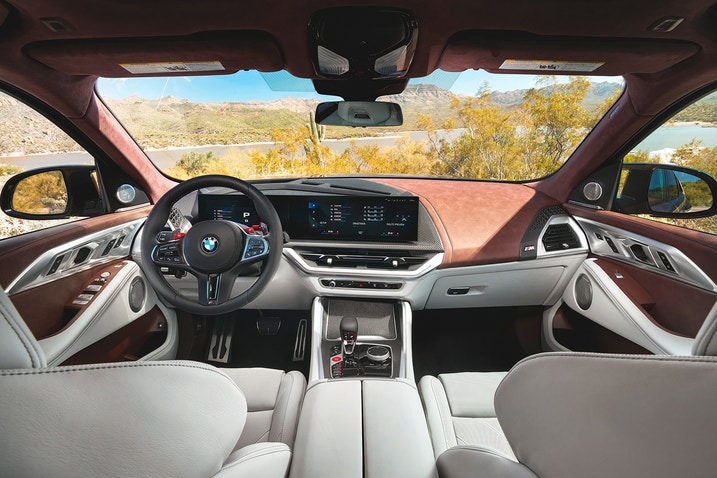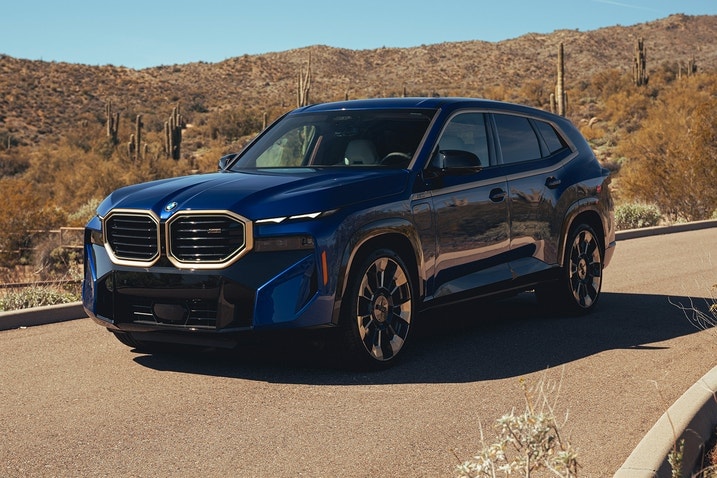- The XM is an all-new super SUV from BMW's M division.
- It boasts a plug-in hybrid V8 powertrain that makes up to 644 horsepower.
- Looks only a mother could love but the interior is luxe.
2023 BMW XM Review: A Perplexing Compromise
Great though it may be to drive, the XM is a confusing propsition
The 2023 XM is the SUV formula BMW started with the X5 back in 1999 taken to its seemingly most illogical conclusion. It's a high-on-style crossover that mashes together luxury, hybrid electrification and the performance of a supercar from 10 years ago. The XM is also BMW's M division's first stand-alone project since the legendary 1978 BMW M1, but it's a performance-oriented, luxuriously appointed, not very pretty SUV that starts at $159,995. How times have changed.
It's a bit bigger than the current-generation X5 and a bit smaller than the X7. It seats five and is about 50% more expensive than a top-spec X7. Oh, and it's a plug-in hybrid, too. But this is PHEV done BMW M style. BMW has corrupted the originally green concept and harnessed it to produce impressive and immediate performance with the side benefit of about 30 miles of battery electric range, should you remember to plug it in.
As different as the XM's styling might be, other luxury SUVs with mind-boggling levels of performance exist, and some also use hybridization to turn up the wick. The Porsche Cayenne Turbo S E-Hybrid is one such option, while the more traditional Mercedes-Benz G 63 AMG and Aston Martin DBX are currently holding many of the prominent parking spots outside of trendy restaurants and nightclubs.
What's under the XM's hood?
Drafted into duty for the XM is BMW's newest version of its familiar 4.4-liter twin-turbo V8. On its own, the engine churns out a healthy 483 horsepower and 479 lb-ft of torque. But when mated up to the XM's electric motor, they combine to produce 644 hp and 590 lb-ft. Smartly packaged inside the transmission case, the electric motor itself pulls from a 25.7-kWh battery mounted in the underbody. BMW says it also grants the XM a pure electric range of up to 30 miles.
The transmission with its built-in motor sends power to all four wheels via M's version of xDrive. Thanks to launch control and the added benefit of all-wheel-drive traction, BMW says the XM will hit 60 mph from a standstill in 4.1 seconds (though we're assuming that's a conservative figure, as BMWs have often bested their touted 0-60 times in our testing) and hustle its way to a 168 mph top speed, should you specify it with the M Driver's package. Without it, top speed is limited to 155 mph. Top speed in electric-only mode is a freeway-practical 87 mph.
As with most modern all-wheel-drive M cars, there are a plethora of driving modes to pick from. The default mode is called 4WD, though in actuality this is an all-wheel-drive setup. There is also a 4WD Sport mode that sends more power rearward and mandates the stability control system be turned off. There is also a 4WD Sand mode that locks the rear differential and can be used for environments where traction is limited like sandy or muddy terrain. Unlike other M performance cars — but perhaps unsurprisingly given this is an SUV — there isn't a rear-wheel-drive-only mode.
An adaptive suspension specifically tuned by M is standard on the XM. The system combines electronically controlled shock absorbers with a set of fixed-rate steel springs up front and progressive-rate springs in the rear. The front suspension is a double-wishbone design while the rear is a five-link setup. There is also a 48-volt anti-roll system (powered by supercapacitors that allow the system to react more quickly than if fed by a battery) that should help keep body motions to a minimum. That combined with a rear-wheel steering system will hopefully make the 6,062-pound SUV (that's roughly the same weight as a Ford Raptor R) a little more agile.
How does the XM drive?
To look at it, you'd be right to expect the XM to drive like a big, thunderous SUV but it's not quite either of those adjectives. From the driver's seat, the XM feels more like an X3 in size and displays a lightness and precision that were a little unexpected. Much of that credit goes to the XM's four-wheel steering (BMW calls it Integral Active Steering). The use of steel springs, in place of air springs other SUVs of this ilk more commonly use, is a real M division move (all the true M cars use them) and certainly adds to the feeling of precision you get in the XM. But they do have some drawbacks, mainly in the way of an extremely stiff ride.
But we'll talk about what it's like to mash the gas and electrons in the XM first. Power is, unsurprisingly, substantial and immediate. Thanks to the clever location of the electric motor, its effects are instantly felt, especially when you're pulling away from a stop. A light touch is needed to be smooth, but under pure electric power, the XM accelerates smartly around town without having to wake the internal combustion engine. When the V8 does wake up, power is added seamlessly and the XM's pace picks up with just the right amount of exhaust noise. Of note, the synthetic electric propulsion sound can run concurrently with noise from the XM's four stacked exhaust pipes. It's an interesting mix.
Full throttle in the XM is never quite breathtaking (we think that experience will be reserved for the upcoming 735-hp Label Red edition of the XM), but the XM moves imperiously through traffic. Shifts from the eight-speed transmission are usually on the smooth side but can be dialed up to be a bit more aggressive if that's your thing. Of course this will quickly deplete the battery, but in our time in the XM, we found it capable of recuperating quite a bit of energy, especially on downhill grades.
Thanks to the 48-volt active stabilizer bars, the XM maintains a flat posture through turns, even when being driven aggressively. The adaptive dampers on the XM are more than up to the task of managing the weight of everything, and they provide excellent body control even over undulating surfaces. Even with all the XM's power, traction out of slower corners is immense and it's very clear this SUV has been developed from the start by BMW's M division.
How comfortable is the XM?
This is where the XM's raison d'être gets a bit muddy. Those steel springs we mentioned earlier might deliver better handling and precise steering, but they also result in a ride that can charitably be described as rigid. Our first few miles in the XM on city streets had us attempting to switch out of the most dynamic drive mode into something more comfortable only to find that it was already in its softest setting. We're sure the choice of 22- or 23-inch wheels doesn't do the ride any favors either. Rear passengers will appreciate the progressive-rate steel springs in the back of the XM, but the ride remains very stiff and very busy on all but the smoothest roads.
Those giant wheels and ultra-low-profile tires create a fair bit of road noise, too. It's not so much that a little music won't drown most of it out, but driving over seams and small divots was always accompanied by a noticeable "thwap" from the tires. We think the side mirrors were the source of any wind noise we heard, but again, a little music from the XM's excellent audio system would take care of that.
The front seats are comfortable, supportive and highly adjustable, but the rear seats, though attractive, lack any real shape or bolstering to hold occupants in place. There's plenty of head- and legroom, but you'll need to hold onto the door handles if the driver picks up the pace.
How's the XM's interior?
Inside, the XM is a pretty stylish place to spend time. BMW's Merino leather (an upgraded option on many other high-end BMWs) coats the XM's seats, while the more typical Nappa leather trims the instrument panel surround and door panels. Alcantara faux suede further decorates the window pillars. Even though the design is reminiscent of the X7 and other BMW SUVs, the new trimmings elevate the space into something that looks even more expensive than other top-dollar Bimmers. There are a plethora of interior options to help customers design a space that's unique to them.
Another option is the available Vintage Coffee Merino leather trim. It coats the upper sections of the instrument panel and door panels in a leather that looks like it's been lifted straight off your great-grandfather's smoking chair. The distressed look that highlights the leather's natural imperfections might not be everyone's cup of tea, but it is a unique touch we haven't seen another mainstream automaker, premium or otherwise, make available.
How's the XM's tech?
As you'd expect from a new BMW, the iDrive 8 infotainment system is standard and powers the central touchscreen that sticks out from the dash. The instrument panel is a digital display with its own set of M-specific readouts. It's augmented by a head-up display that projects info onto the glass above the instrument cluster. The touchscreen is within easy reach of both front seat passengers, and we found ourselves eschewing the iDrive's controller and simply making our selections via the fast-acting touchscreen.
BMW touts the XM as having the largest number of advanced driver systems as standard equipment on any M vehicle. Known as the Driving Assistant group, it includes adaptive cruise control, forward collision warning, lane departure warning with steering correction, evasion assist, a driver attention monitoring system and a few other features. That's not a bad starting point but we think BMW is being a little stingy with the standard features. You'll need to add the Driving Assistant Professional package for the more advanced adaptive cruise control with lane keeping assistance, lane change assistance and cross-traffic warning.
Edmunds says
The XM is a perplexing luxury statement. Brash and divisive styling (we do think the quad stacked tailpipes are cool) and an eye-catching interior are mixed with impressive engineering, strong performance and that legendary M division pedigree. But that performance comes at the expense of true luxury and the XM feels a bit conflicted and out of place in BMW's lineup. We're sure there are buyers who have been wanting BMW to produce something that makes more of a statement than its usual assortment of SUVs, but we're curious to see how it stacks up to its many and varied rivals in the real world. Much like the X6, which many people, including us, reviled upon its introduction, the XM might prove to be a bit of a trendsetter. Stick with Edmunds for our Expert Rating and full review of the XM in the coming months.










 by
by